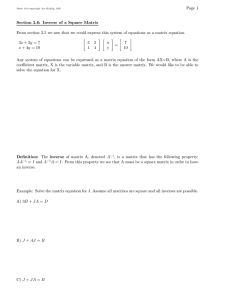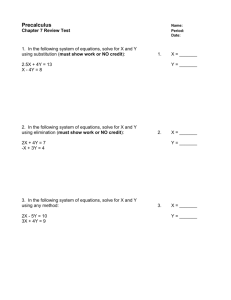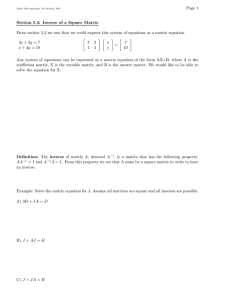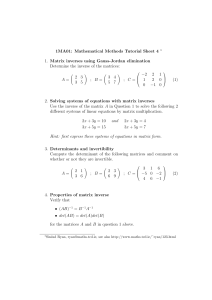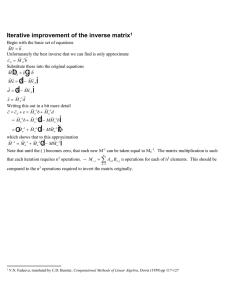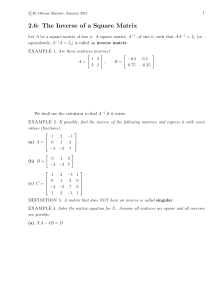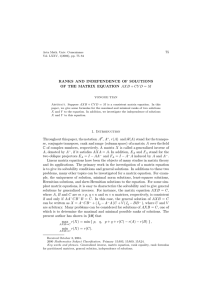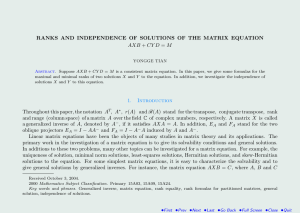Document 10677175
advertisement
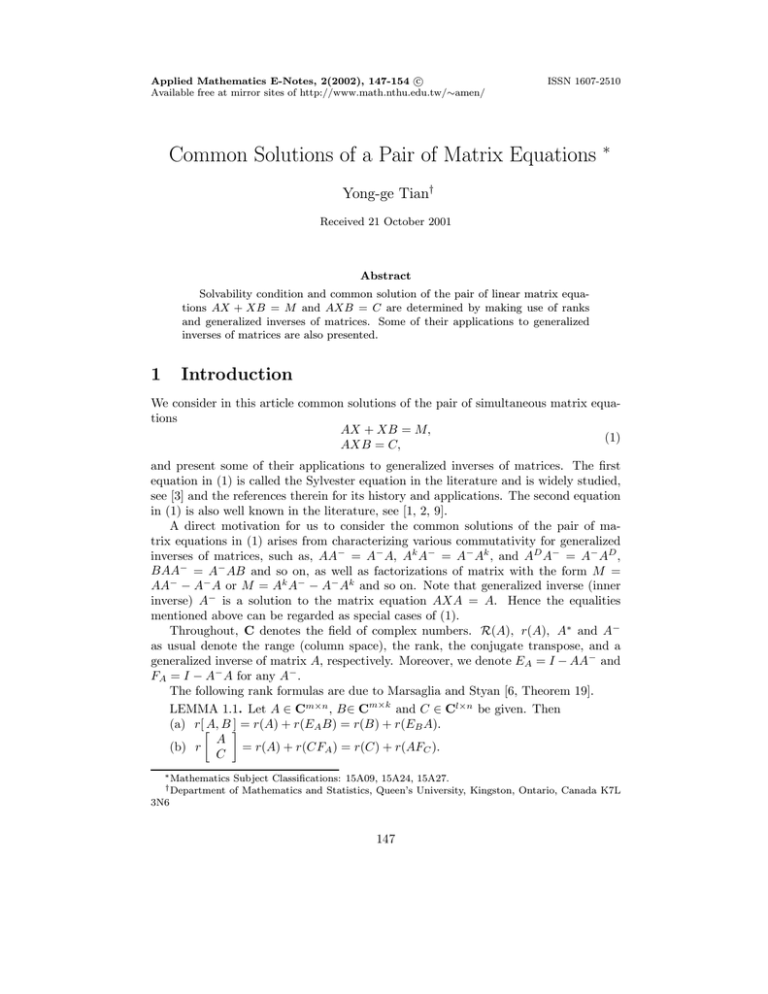
Applied Mathematics E-Notes, 2(2002), 147-154 c Available free at mirror sites of http://www.math.nthu.edu.tw/∼amen/ ISSN 1607-2510 Common Solutions of a Pair of Matrix Equations ∗ Yong-ge Tian† Received 21 October 2001 Abstract Solvability condition and common solution of the pair of linear matrix equations AX + XB = M and AXB = C are determined by making use of ranks and generalized inverses of matrices. Some of their applications to generalized inverses of matrices are also presented. 1 Introduction We consider in this article common solutions of the pair of simultaneous matrix equations AX + XB = M, (1) AXB = C, and present some of their applications to generalized inverses of matrices. The first equation in (1) is called the Sylvester equation in the literature and is widely studied, see [3] and the references therein for its history and applications. The second equation in (1) is also well known in the literature, see [1, 2, 9]. A direct motivation for us to consider the common solutions of the pair of matrix equations in (1) arises from characterizing various commutativity for generalized inverses of matrices, such as, AA− = A− A, Ak A− = A− Ak , and AD A− = A− AD , BAA− = A− AB and so on, as well as factorizations of matrix with the form M = AA− − A− A or M = Ak A− − A− Ak and so on. Note that generalized inverse (inner inverse) A− is a solution to the matrix equation AXA = A. Hence the equalities mentioned above can be regarded as special cases of (1). Throughout, C denotes the field of complex numbers. R(A), r(A), A∗ and A− as usual denote the range (column space), the rank, the conjugate transpose, and a generalized inverse of matrix A, respectively. Moreover, we denote EA = I − AA− and FA = I − A− A for any A− . The following rank formulas are due to Marsaglia and Styan [6, Theorem 19]. LEMMA 1.1. Let A ∈ Cm×n , B∈ Cm×k and C ∈ Cl×n be given. Then (a) r[ A, B ] = r(A) + r(EA B) = r(B) + r(EB A). A (b) r = r(A) + r(CFA ) = r(C) + r(AFC ). C ∗ Mathematics † Department Subject Classifications: 15A09, 15A24, 15A27. of Mathematics and Statistics, Queen’s University, Kingston, Ontario, Canada K7L 3N6 147 148 (c) r Matrix Equations A B C 0 = r(B) + r(C) + r(EB AFC ). From Lemma 1.1(c), we obtain r A EC1 C BFB1 0 A = r C 0 B 0 B1 0 C1 − r(B1 ) − r(C1 ). 0 (2) Lemma 1.1 and (2) are quite useful in simplifying various rank equalities involving generalized inverses of matrices. The following result on the matrix equation AXB = C is also well known, see [1, 2, 9]. LEMMA 1.2. The following five statements are equivalent: (a) The matrix equation AXB = C is consistent. (b) AA− C = C and CB − B = C. (c) AA− CB − B = C. (d) R(C) ⊆ R(A) and R(C ∗ ) ⊆ R(B ∗ ). B (e) r[ A, C ] = r(A) and r = r(B). C In case one of the five statements in Lemma 1.2 holds, the general solution of AXB = C can be expressed in the form X = A− CB − + V − A− AV BB − , or X = A− CB − + FA V1 + V2 EB , where V, V1 and V2 are arbitrary matrices. LEMMA 1.3. Let A ∈ Cm×p , B∈ Cq×n , C∈ Cm×r , D ∈ Cs×n and N ∈ Cm×n be given. Then (a) The matrix equation AXB + CY D = N (3) is solvable if and only if the following four rank equalities hold [8] B B r[ A, C, N ] = r[ A, C ], r D = r , D N r N D A 0 = r(A) + r(D), r N B C 0 = r(B) + r(C). (4) (5) (b) In case (3) is solvable, the general solution of Eq.(3) can be expressed in the form [11, 12] X = X0 + X1 X2 + X3 and Y = Y0 + Y1 Y2 + Y3 , (6) where X0 and Y0 are two special solutions of Eq.(3), X1 , X2 , X3 and Y1 , Y2 , Y3 are the general solutions of the following four homogeneous matrix equations AX1 − CY1 = 0, X2 B + Y2 D = 0, AX3 B = 0, CY3 D = 0, (7) Y. G. Tian 149 or explicitly X = X0 + [ Ip , 0 ]FG U EH Y = Y0 + [ 0, Ir ]FG U EH Iq 0 0 Is + FA V1 + V2 EB , (8) + FC W1 + W2 ED , (9) where X0 and Y0 are two special solutions of Eq.(3), G = [ A, −C ], H = B D , U, V1 , V2 , W1 and W2 are arbitrary. Some expressions of special solutions of (3) were given in [1] and [8]. But we only need (8) and (9). 2 Main Results Our first main result is as follows. THEOREM 2.1. Let A ∈ Cm×m , B ∈ Cn×n and C, M ∈ Cm×n be given. Then (a) The matrix equations AX + XB = M, AXB = C (10) have a common solution X if and only if A, B, C, M satisfy the following six conditions R(C) ⊆ R(A), R(C ∗ ) ⊆ R(B ∗ ), r M B A 0 = r(A) + r(B), AC + CB = AM B, R( C − AM ) ⊆ R(A2 ), R[( C − M B )∗ ] ⊆ R[(B 2 )∗ ]. (11) (12) (b) In case (11) and (12) hold, the general common solution of (10) can be expressed in the form X = X0 + [ FA , 0 ]FG U EH In 0 + [ 0, Im ]FG U EH 0 EB where X0 is a special solution of Eq.(10), G = [ FA , −A ], H = + FA SEB , B EB (13) , U and S are arbitrary. (c) The equations in (10) have a unique common solution if and only if A and B are nonsingular and AC + CB = AM B. In this case, the unique common solution is X = A−1 CB −1 . PROOF. Suppose first that (10) has a common solution. This implies that AX + Y B = C and AXB = C are solvable respectively. Thus (11) follows directly from Lemmas 1.2 and 1.3. Pre- and post-multiplying A and B of the both sides of AX + XB = M , respectively, yield A2 X = AM − C and XB 2 = M B − C, which imply the two range inclusions in (12). Consequently, pre- and post-multiplying A and B on the both sides of AX + XB = M produces the first equality in (12). 150 Matrix Equations We next show that under (11) and (12), the two equations in (10) has a common solution and their general common solution can be written as (13). By Lemma 1.2, the general solution of AXB = C under (11) is X = A− CB − + FA V1 + V2 EB , (14) where V1 and V2 are arbitrary. Substituting it into AX + XB = M yields AV2 EB + FA V1 B = M − CB − − A− C. (15) By Lemma 1.3, this equation is solvable if and only if it satisfies the following four rank equalities B B , (16) r[ A, FA , N ] = r[ A, FA ], r EB = r EB N and r N B A 0 = r(A) + r(B), r N EB FA 0 = r(FA ) + r(EB ), (17) where N = M − CB − − A− C. Simplifying them by Lemma 1.1 and (2), we find that r[ A, FA , N ] = r A Im 0 A M − A− C 0 A Im 0 A r[ A, FA ] = r B B In r EB = r M − CB − N r r r N EB N B FA 0 − r(A) = r[ A2 , C − AM ] + m − r(A), − r(A) = r(A2 ) + m − r(A), 0 B − r(B) = r 0 B EB =r B In 0 B A 0 =r M − CB − − A− C B B2 C − MB + n − r(B), − r(B) = r(B 2 ) + n − r(B), A 0 =r M B A 0 , M − CB − − A− C Im 0 In 0 B − r(A) − r(B) = r 0 A 0 0 Im 0 − r(A) − r(B) 0 = r In 0 0 0 AM B − AC − CB = m + n + r(AM B − AC − CB) − r(A) − r(B), and r(FA ) + r(EB ) = m + n − r(A) − r(B). Y. G. Tian 151 Substituting them into (16) and (17) yields the results in (11) and (12). This fact implies that under (11) and (12), the equation (15) is solvable. Solving for V1 and V2 in (15) by Lemma 1.3, we obtain their general solutions V1 = V10 + A− AS1 + S2 EB +[ Im , 0 ]( I − [ FA , −A ]− [ FA , −A ] )U V2 I− B EB B EB I− B EB B EB − In 0 , 0 In , = V20 + FA T1 + T2 BB − +[ 0, Im ]( I − [ FA , −A ]− [ FA , −A ] )U − where V10 and V20 are two special solutions of (15), U, S1 , S2 , T1 and T2 are arbitrary. Substituting them into (14) yields X = A− CB − + FA V10 + V20 EB + [FA , 0 ]FG U EH +FA S2 EB + [ 0, Im ]FG U EH 0 EB In 0 + FA T1 EB , which can also be written in the form of (13). The proof is complete. Some direct consequences can be derived from the above theorem. Here are some of them. COROLLARY 2.2. Let A, M ∈ Cm×m be given. Then (a) There is A− such that M = AA− − A− A (18) if and only if A and M satisfy the following four conditions AM A = 0, R(A + AM ) ⊆ R(A2 ), M A R[(A − M A)∗ ] ⊆ R[(A2 )∗ ], r A 0 = 2r(A). (b) Under r(A2 ) = r(A), there is A− such that Eq.(18) holds if and only if AM A = 0 and r M A A 0 = 2r(A). (c) There is A− such that M = AA− + A− A if and only if A and M satisfy the following four conditions 2A2 = AM A, R( A − AM ) ⊆ R(A2 ), (19) 152 Matrix Equations R[( A − M A )∗ ] ⊆ R[(A2 )∗ ], r M A A 0 = 2r(A). (d) Under r(A2 ) = r(A), there is A− such that Eq.(19) holds if and only if 2A2 = AM A and r M A A 0 = 2r(A). (e) There is A− such that AA− = A− A holds if and only if r(A2 ) = r(A) [13]. Indeed, applying Theorem 2.1 to the system AX − XA = M and AXA = A yields the results in the corollary. An extension of Theorem 2.1 is given below. Its proof is similar to that of Theorem 2.1 and is therefore omitted. THEOREM 2.3. Let A ∈ Cm×k , B ∈ Cl×n , A1 ∈ Ck×k , B1 ∈ Cl×l , C ∈ Cm×n , M ∈ C and suppose that k×l R(A∗1 ) ⊆ R(A∗ ) and R(B1 ) ⊆ R(B). (20) Then the following matrix equations A1 X + XB1 = M, AXB = C (21) have a common solution X if and only if the following conditions are satisfied: R(C) ⊆ R(A), R(C ∗ ) ⊆ R(B ∗ ), r M B1 A1 0 = r(A1 ) + r(B1 ), AA1 A− C + CB − B1 B = AM B, (22) (23) R( AM − CB − B1 ) ⊆ R(AA1 ), R[( M B − A1 A− C )∗ ] ⊆ R[(B1 B)∗ ]. (24) M = Ak A− − A− Ak (25) COROLLARY 2.4. Let A, M ∈ Cm×m be given. Then there is A− such that if and only if A and M satisfy the following four conditions AM A = 0, R( Ak + AM ) ⊆ R(Ak+1 ), R[(Ak − M A)∗ ] ⊆ R[ (Ak+1 )∗ ], (26) Ak 0 (27) r M Ak = 2r(Ak ). In particular, there is A− such that Ak A− = A− Ak holds if and only if r(Ak+1 ) = r(Ak ) [13]. PROOF. In fact, (25) is equivalent to Ak X − XAk = M and AXA = A. Thus (25)—(27) follow from (20)—(24). COROLLARY 2.5. Let A ∈ Cm×m be given. Then there exists A− such that A A− = A− AD , where AD is the Drazin inverse of A. D Y. G. Tian 153 PROOF. It is obvious that AD A− = A− AD is equivalent to AD X = XAD and AXA = A. (28) Note that R(AD ) ⊆ R(A) and R[(AD )∗ ] ⊆ R(A∗ ). Then applying Theorem 2.3 to (28) yields the desired result. COROLLARY 2.6. Let A, B ∈ Cm×m be given. Then there is A− such that BAA− = A− AB (29) r(ABA) = r(AB) = r(BA). (30) if and only if PROOF. The equality (29) is equivalent to the pair of matrix equations BAX = XAB and AXA = A. Thus (30) is derived from Theorem 2.3. In particular when B is taken such that r(ABA) = r(A), there exists A− satisfying (29). In this case, this generalized inverse is called the commutative generalized inverse of A with respect to B and is denoted by A− B , which was examined in Khatri [5]. Note that r(AA∗ A) = r(AA∗ ) = r(A∗ A) = r(A). Thus any square matrix A has † a commutative generalized inverse A− A∗ . In fact, the Moore-Penrose inverse A is a − special case of the commutative generalized inverse AA∗ . Acknowledgments. The author would like to thank the referee for valuable suggestions. The research of the author was supported in part by the Natural Sciences and Engineering Research Council of Canada. References [1] J. K. Baksalary and R. Kalar, The matrix equation AXB + CY D = E, Linear Algebra Appl., 30(1980), 141—147. [2] A. Ben-Israel and T. N. E. Greville, Generalized Inverses: Theory and Applications, R. E. Krieger Publishing Company, New York, 1980. [3] R. Bhatia and P. Rosenthal, How and why to solve the operator equation AX − XB = Y , Bull London Math. Soc., 29(1997), 1—21. [4] C. G. Khatri, A note on a commutative g-inverse of matrix, Sankhyā Ser. A, 32(1970), 299—310. [5] C. G. Khatri, Commutative g-inverse of a matrix, Math. Today, 3(1985), 37—40. [6] G. Marsaglia and G. P. H. Styan, Equalities and inequalities for ranks of matrices, Linear and Multilinear Algebra, 2(1974), 269—292. 154 Matrix Equations [7] S. K. Mitra, A pair of simultaneous linear matrix equations A1 XB1 = C1 and A2 XB2 = C2 and a programming problem, Linear Algebra Appl., 131(1990), 107—123. [8] A. B. Özgüler, The equations AXB + CY D = E over a principal ideal domain, SIAM J. Matrix Anal. Appl., 12(1991), 581—591. [9] C. R. Rao and S. K. Mitra, Generalized Inverse of Matrices and Its Applications, Wiley, New York, 1971. [10] R. E. Roth, The equations AX − Y B = C and AX − XB = C in matrices, Proc. Amer. Math. Soc., 3(1952), 392—396. [11] Y. Tian, The general solution of the matrix equation AXB = CY D, Math. Practice and Theory, 1(1988), 61—63. [12] Y. Tian, Solvability of two linear matrix equations, Linear and Multilinear Algebra, 48(2000), 123—147. [13] Y. Tian, The maximal and minimal ranks of some expressions of generalized inverses of matrices, Southeast Asian Bull. Math., 25(2002), 745-755.
